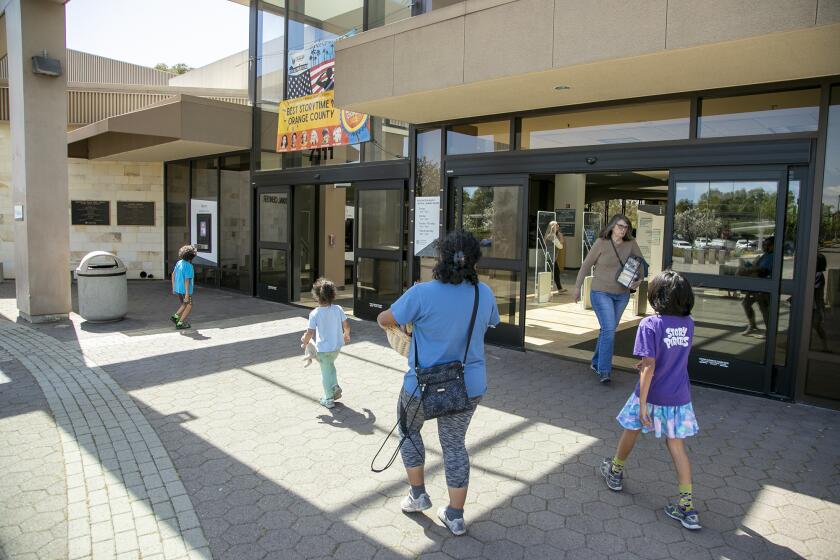Column: Fatherhood takes many forms, traditional and not, these days
- Share via
Sunday is Father’s Day, and it’s certainly fitting that we take a moment to celebrate dads.
But at a time when we are expanding our concept of what constitutes a family, we might also consider that we have been rethinking what it means to be a father.
In 1960, nearly three-fourths of American children lived in a family with two married parents in their first marriage. Today, less than half of all children actually grow up in a so-called “traditional family,” with a married mom and dad.
These days it’s just as likely for kids to be raised in households with single parents, blended families, grandparents or other family members at the helm, same-sex parents or a variety of other situations.
“There is no longer one dominant family form in the U.S.,” the Pew Research Center announced in late 2015. “Parents today are raising their children against a backdrop of increasingly diverse and, for many, constantly evolving forms.”
At the same time, the old stereotype of a breadwinning, authoritative father who abdicates most of the day-to-day child rearing responsibilities to the mother has been largely upended in modern times. Most moms today work outside the home and many have become their family’s primary sources of income.
Today’s dads are just as likely to know the finer points of diaper changing, attend parent-teacher conferences and arrange pick-ups at their kids’ dance classes. Despite the growth in non-traditional family structures, many modern fathers wouldn’t even consider being a hands-off parent to be a viable option.
The situation remains fluid. According to an analysis by the polling firm Gallup, millennials are delaying marriage longer than any generation before them. Families — and the role of fathers along with them — will continue to evolve.
Yet it’s possible that our notions of fatherhood have always been somewhat skewed. Bear in mind that the movement to establish an official day to honor fathers began because of one woman’s love for her single dad.
The idea was spearheaded back in the early 20th century by Sonora Smart Dodd, who was inspired by her father, a widower who raised six children on his own in rural Washington.
Indeed, one could argue that the old-fashioned view of fathers has always been more myth than reality — a myth perpetuated by sexist advertising jingles and the homespun themes of television shows in the 1950s and 1960s.
But there’s no denying that times are changing, and the way we view Father’s Day underscores that change.
On the one hand, there are those who see both Mother’s Day and Father’s Day as outdated relics that unfairly sideline those in less-traditional family situations. A Canadian elementary school, for instance, unwittingly instigated a minor media ruckus when it announced that it would cancel all school-related Mother’s Day and Father’s Day activities this year in the service of diversity and inclusiveness.
On the other hand, Father’s Day appears far from any danger of dying out. This year, Americans are expected to spend a record $15.5 billion on Father’s Day, shattering last year’s record-setting $14.3 billion, according to the National Retail Federation. The biggest share of that spending will be on experiences, such as tickets to a ballgame or concert, or on celebratory meals, the NRF predicted.
The difference is that, in keeping with the trend toward less conventional family structures, we will see Father’s Day increasingly viewed more expansively, as a way to show our appreciation not just to fathers, but to father figures. This would include stepdads, certainly, but also uncles, older brothers, favorite teachers, coaches and other role models who might have been been instrumental in shaping young lives.
I, for one, plan to spend the day joining my sons in showing appreciation for their father, my husband of more than three decades, and I’ll also take a few moments to remember my own dear dad. I never considered myself as particularly concerned with being conventional, but I suppose our family is as close to the traditional blueprint as they come these days.
But I also see the holiday as an appropriate time to thank in particular my father-in-law and my late big sister’s husband, both of whom have treated me with fatherly devotion and affection.
I imagine other celebrants today might focus their attention on other family members and key mentors who, while not their fathers in the strictest sense, have supported them in father-like fashion.
Change can be uncomfortable, and many Americans will likely view the evolving family unit and the accompanying evolution of fatherhood with great trepidation.
I’d argue that it’s pointless to bemoan a past that no longer exists — or might never have existed in quite the way that our nostalgia leads us to imagine.
Families in all their many forms are still families, dads who have embraced more broad-minded views of their roles are still dads, and Father’s Day is still an occasion to show our gratitude for those who lifted us up and carried us on their shoulders.
Happy Father’s Day.
PATRICE APODACA is a former Newport-Mesa public school parent and former Los Angeles Times staff writer. She lives in Newport Beach.
All the latest on Orange County from Orange County.
Get our free TimesOC newsletter.
You may occasionally receive promotional content from the Daily Pilot.




